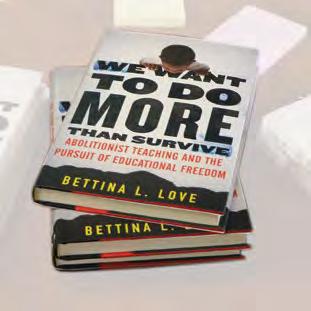Dallas ISD teachers now lead gallery walks in which students post their thoughts on large sheets of paper hung on the wall and then walk the room to read different viewpoints. Teachers also place students into pair or trio discussions in which students have small group discussions guided by a teacher’s prompt. Quick writes are another innovative instructional tool introduced by the Pitt researchers. Students are told to quickly write down their thoughts in response to a writing prompt. The writing is meant to be a predecessor to a formal outline or first draft. The act helps students to organize their thoughts, which prepares them for when it is time to write the longer assignment. To show their students how this works, some teachers have put themselves on the spot. One teacher did her own quick write on a subject unfamiliar to her but well known to her students: the lyrics of a song by the Atlanta rapper Lil Baby. The teacher struggled mightily. The students shared a laugh at her expense. But that was okay. The students got the message. “Modeling vulnerability for children is one of the most important things you can do for a child. It shows that making mistakes isn’t just tolerated, it’s a vital part of the process,” says Darlene Seeley, a ninth-grade English teacher at W.T. White High School.
Preparing Students for Life
T
here are still several years to go in the project, but early results are promising, according to school officials. Tracie Washington, executive director of the Dallas ISD, recalls a recent visit to an eighth-grade classroom. The teacher was leading a discussion on the poem “We Wear the Mask” by Paul Laurence Dunbar. At that moment, a Black male who was an athlete—a person who appeared to be very reserved in the back of the room— voluntarily spoke up. He identified the poem as an extended metaphor, which caused the class to erupt into a spirited debate. “It was like watching a volleyball going back and forth, watching the conversation around the room. It is the epitome of what I want to see happen in the students’ discussion of the text,” says Washington. Another observation that is important to senior administration at the Dallas ISD
Measuring the Health of Networks
is that schools are starting to demonstrate quantifiable gains in writing. “It’s starting to stick. We’re seeing double-digit gains in every area in the common assessment this year versus last year,” says Washington. Principals are noticing positive changes in their schools as well. “The process is not only helping our students to become more proficient writers, it helps the teachers to hone their craft. Both are growing together,” says Jonathan Smith, principal of David W. Carter High School. Diana Nuñez, principal of W.H. Adamson High School, has been an educator in the Dallas ISD for nearly 20 years. She has been amazed by how involved the students have become in their writing assignments, which she says “is not always the case.” She attributes the success to the buy-in by the teachers and the cultural relevance of the texts. “Our main goal is to prepare kids for life, not just the test. The more rigor that we infuse, that increases our chance of meeting it,” said Nuñez. Ivonne Durant, chief academic officer of Dallas ISD, says there is interest in expanding the project’s reach and increasing teachers’ professional development opportunities. She has heard from administrators in the pilot schools who want to expand it to additional grade levels and from administrators outside the project who want to have their schools join the pilot. “It’s never easy to work with a district as large and diverse as ours. We have the highest poverty levels in the state of Texas. Our English learners population exceeds the state average. I’ve seen the work that our children are now producing, though.
The initiative in the Dallas ISD is an example of a network for school improvement. Beyond this project, School of Education faculty member Jennifer Russell has received a $1.5 million grant from the Bill & Melinda Gates Foundation to assess the health of other networks for school improvement that are occurring nationwide. “The project seeks to answer how network leaders and the Gates Foundation can support the development and health of these networks,” says Russell.
It exceeds my wildest dreams,” says Durant. Positive results also are occurring at the Thomas C. Marsh Preparatory Academy, where teachers and students have embraced the changes that are requiring higher-order cognitive thinking, says Brittany Thompson, an assistant principal who oversees the English language arts department. It is her habit to refer to students in the school as “scholars.” She explains that this is because they are increasingly taking ownership of their learning journey. “This work has made our scholars feel more accountable. We’re not spoonfeeding it to them anymore. They are doing the work,” says Thompson. Araujo, the eighth grader at Marsh, is among the students who enjoy the added instructional rigor. As he prepares to enter high school, he says his favorite book is the Holocaust memoir “Night” by Elie Wiesel. The book opened his eyes to worldviews outside the United States. “In college, I know that everyone has to write a lot of essays. We are practicing a lot for that now,” says Araujo. His classroom experience is now more enjoyable. It also is preparing him for a brighter future. ◆








